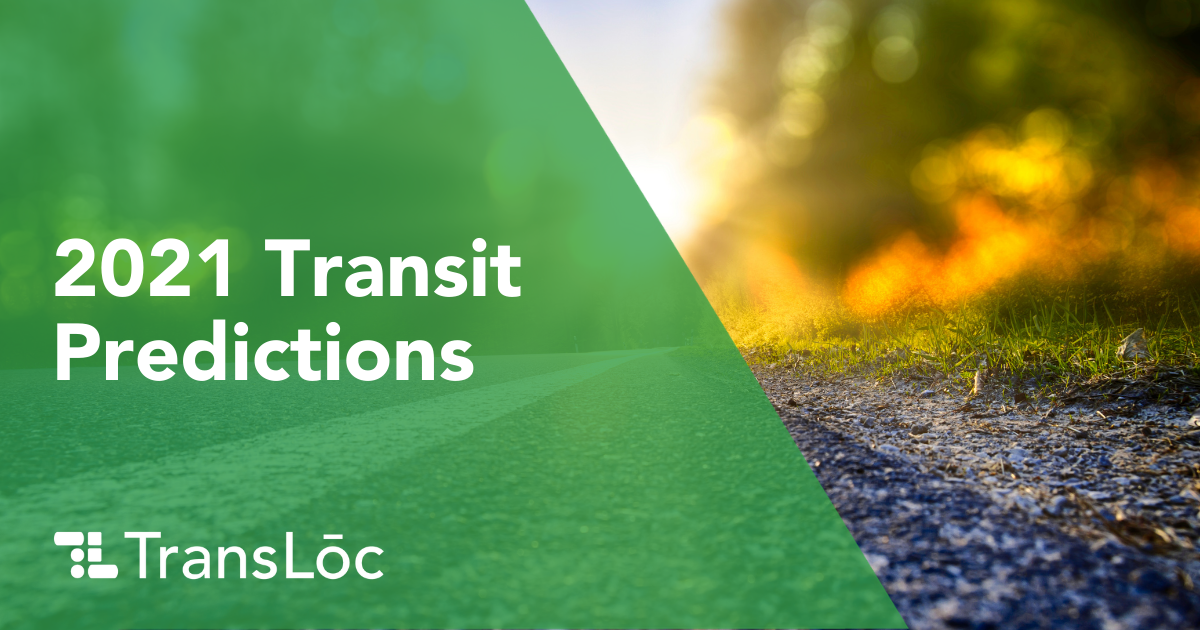
What does 2021 have in store for transportation? We don’t have a crystal ball, but our solutions engineers have a strong pulse on the industry and have made their predictions for the upcoming year:
1. Transportation providers will be held to a higher standard of service and equity by their communities.
This past year has reinvented the way we work, learn, and connect. We cannot go back to how things were. Transit providers must meet the changing expectations of riders by forgoing a blanket “one size fits all” strategy, and they must begin providing unique service for unique areas. Modes that were once considered experimental will become crucial as transit agencies race to adapt to a transformed mobility landscape and transformed rider preferences. Communities have been demanding equity analysis in transportation planning for decades, and planners are finally realizing the impact of examining equity in the planning process. In 2021, riders and communities will hold transit agencies accountable to consider equity and disparities in transit access and investment.
2. From the lab to the lane: recent advances in transportation technology will go mainstream as public and private agencies alike seize the opportunity to reshape the transportation landscape.
Short-term demonstrations of autonomous shuttles saw a small boom leading into 2020, but full-scale autonomous vehicle pilot programs have thus far been focused on current hotspots like Pittsburgh, Phoenix, and Silicon Valley. We believe AV pilots will be operating in a majority of states by year’s end including at least one autonomous heavy-duty public transit vehicle. Additionally, the recent advancement of electrification technology combined with a renewed focus on greenhouse gas emissions will see electric vehicles outsell diesel in the public transit space for the first time. Vehicles are hardly the only realm likely to see investment. There will be opportunities for increased use of fixed sensor technology in projects like the proposed Detroit-Ann Arbor corridor, as well as new means of inter-vehicle and infrastructure-to-vehicle communication.
3. Traffic congestion will be back and worse than ever.
Many of us marveled at images of empty city streets and once-congested freeways void of all vehicles. But we’ve already seen the return of traffic congestion in many places, and this is likely to get worse as automobile sales have skyrocketed in 2020. This means we will once again be stuck in traffic, and it carries serious environmental justice implications for freeway-adjacent communities who will face health impacts from increased emissions.
4. Public transportation as customer service: mobile and contact free ticketing.
Public transit riders in 2021 will be driven by a newfound perspective of their own interactions with transit, and agencies will refocus on customer experience to rebuild trust in the system. Riders who may have chosen to stop riding transit in favor of driving, walking, or cycling, may be wary of returning to transit in the near-term, so implementing technology such as mobile, touchless ticketing as well as continued emphasis on sanitation of vehicles will instill more confidence in these riders and ease concerns of exposure.
5. Providing fast and frequent transit will become more important than ever.
Transit has always been a lifeline for vulnerable communities and essential workers, and the impacts of transit will be multiplied in the economic recovery of 2021. Regions that can provide high quality transit connecting residents to jobs, healthcare, and education will recover more quickly, while regions that delay adapting to the needs of their riders will struggle. The good news is that we also predict an increase in federal discretionary funding for transportation, creating opportunities for cities and regions to act and evolve their transit systems with higher quality services, such as Bus Rapid Transit.
6. 2020’s roadway management experiments will become prominent and permanent in 2021.
Cities across the US (and the world) have reallocated road space to meet the needs of their communities. “Slow Streets” are closed to through-traffic, parking spaces have become outdoor dining zones, and some streets are even getting experimental BRT lines taking advantage of excess capacity. While most of these programs were rolled out as temporary, we predict that people are going to have a hard time giving up this valuable outdoor space which has been taken back from traffic. Active transportation is here to stay, as individuals crave ways to safely connect with their communities.
7. How data plays a role in enhancing the transportation Industry.
Data will play its most important role in 2021. Transit agencies and technology providers will have to work together to become data driven, as opposed to operating based on assumptions. Once agencies are equipped with the data they need and the tools and knowledge to analyze the information, they will be able to implement tactical programs to enhance service and better inform riders. Accurate and digestible data will allow for capacity planning, redefined KPIs that the agency can control and influence, and a key understanding of how to craft performance metrics. Data is the future of transportation, and agencies must be as calculated as possible in 2021 to maintain ridership and run efficient services to provide their communities with safe and reliable transportation.
We are excited and hopeful as we move into a new year. Are you interested in connecting with TransLoc’s Planning & Design team? Email us at solutions-engineers-team@transloc.us. We look forward to hearing from you!